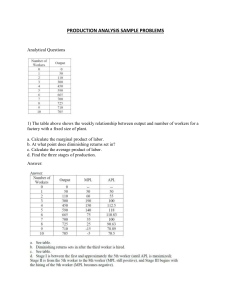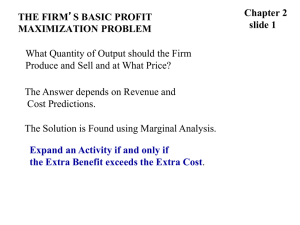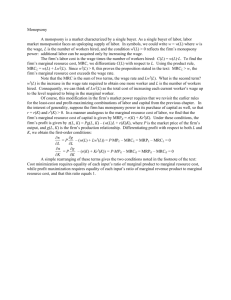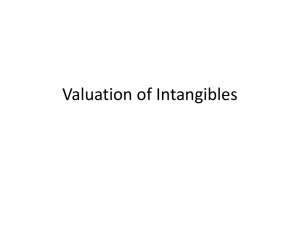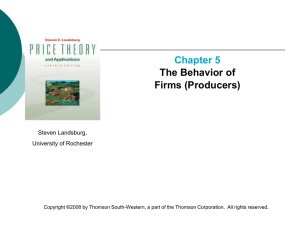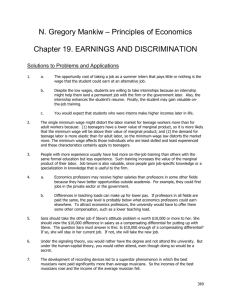ESSENTIALS OF MICROECONOMICS
advertisement
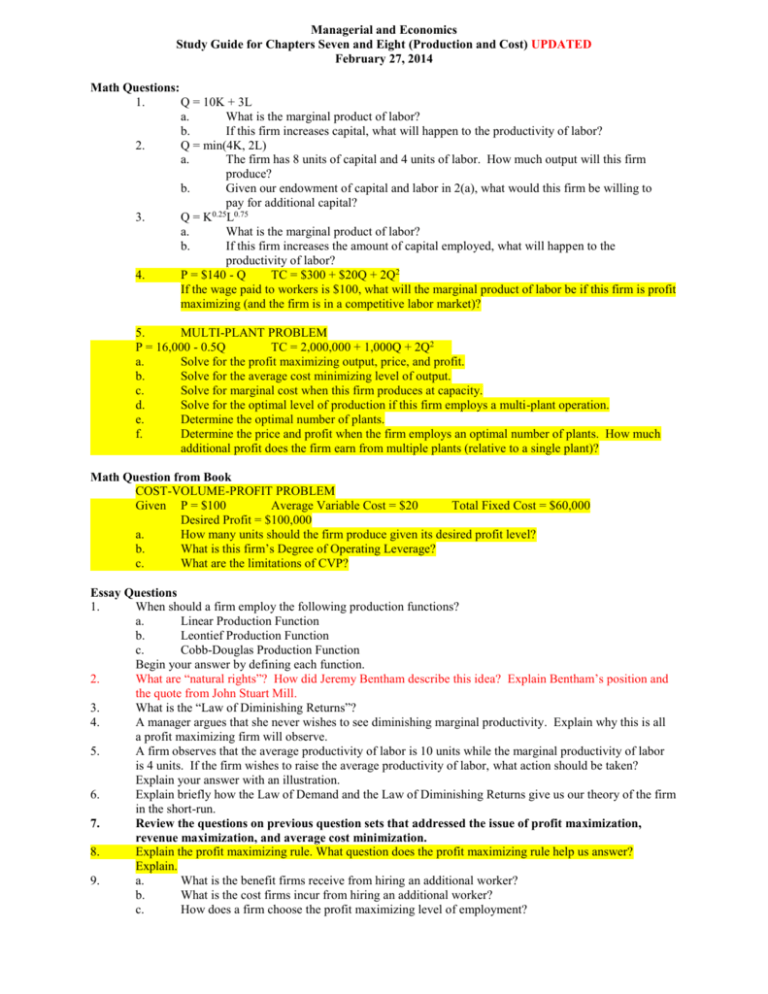
Managerial and Economics Study Guide for Chapters Seven and Eight (Production and Cost) UPDATED February 27, 2014 Math Questions: 1. Q = 10K + 3L a. What is the marginal product of labor? b. If this firm increases capital, what will happen to the productivity of labor? 2. Q = min(4K, 2L) a. The firm has 8 units of capital and 4 units of labor. How much output will this firm produce? b. Given our endowment of capital and labor in 2(a), what would this firm be willing to pay for additional capital? 3. Q = K0.25L0.75 a. What is the marginal product of labor? b. If this firm increases the amount of capital employed, what will happen to the productivity of labor? 4. P = $140 - Q TC = $300 + $20Q + 2Q2 If the wage paid to workers is $100, what will the marginal product of labor be if this firm is profit maximizing (and the firm is in a competitive labor market)? 5. MULTI-PLANT PROBLEM P = 16,000 - 0.5Q TC = 2,000,000 + 1,000Q + 2Q2 a. Solve for the profit maximizing output, price, and profit. b. Solve for the average cost minimizing level of output. c. Solve for marginal cost when this firm produces at capacity. d. Solve for the optimal level of production if this firm employs a multi-plant operation. e. Determine the optimal number of plants. f. Determine the price and profit when the firm employs an optimal number of plants. How much additional profit does the firm earn from multiple plants (relative to a single plant)? Math Question from Book COST-VOLUME-PROFIT PROBLEM Given P = $100 Average Variable Cost = $20 Total Fixed Cost = $60,000 Desired Profit = $100,000 a. How many units should the firm produce given its desired profit level? b. What is this firm’s Degree of Operating Leverage? c. What are the limitations of CVP? Essay Questions 1. When should a firm employ the following production functions? a. Linear Production Function b. Leontief Production Function c. Cobb-Douglas Production Function Begin your answer by defining each function. 2. What are “natural rights”? How did Jeremy Bentham describe this idea? Explain Bentham’s position and the quote from John Stuart Mill. 3. What is the “Law of Diminishing Returns”? 4. A manager argues that she never wishes to see diminishing marginal productivity. Explain why this is all a profit maximizing firm will observe. 5. A firm observes that the average productivity of labor is 10 units while the marginal productivity of labor is 4 units. If the firm wishes to raise the average productivity of labor, what action should be taken? Explain your answer with an illustration. 6. Explain briefly how the Law of Demand and the Law of Diminishing Returns give us our theory of the firm in the short-run. 7. Review the questions on previous question sets that addressed the issue of profit maximization, revenue maximization, and average cost minimization. 8. Explain the profit maximizing rule. What question does the profit maximizing rule help us answer? Explain. 9. a. What is the benefit firms receive from hiring an additional worker? b. What is the cost firms incur from hiring an additional worker? c. How does a firm choose the profit maximizing level of employment? 10. 11. Define the “Law of Diminishing Returns.” As the firm hires additional workers what happens to the marginal productivity (and marginal revenue product) of each additional worker? c. If W > MRP, what action will a profit maximizing firm take? Explain. d. If W < MRP, what action will a profit maximizing firm take? Explain. Define the term ‘monopsony’ and explain the impact monopsony power has on a worker’s wage. Be sure to offer Joan Robinson’s definition of ‘exploitation’. a. b. For 12-17 Answer the following questions with respect to the minimum wage: 12. What year was it first instituted and what was its initial value (in nominal terms)? 13. In what decade was the purchasing power of the minimum wage the highest? 14. List the reasons, as offered in lecture, why economists have trouble assessing the impact of the minimum wage on the welfare of the working poor. 15. With respect to the minimum wage, what does deductive reasoning tell us will be the impact on the welfare of the working poor? What does inductive reasoning tell us is the impact? 16. According to the natural experiment studied by Alan Kruger and David Card (1994) and Dube, Lester, and Reich (2010), what is the impact of raising the minimum wage on employment? 17. How do economists surveyed by IGM generally respond to the following statements? Question A: Raising the federal minimum wage to $9 per hour would make it noticeably harder for lowskilled workers to find employment. Question B: The distortionary costs of raising the federal minimum wage to $9 per hour and indexing it to inflation are sufficiently small compared with the benefits to low-skilled workers who can find employment that this would be a desirable policy. 18. a. Explain the difference between a craft union and an industrial union. How does each type of union achieve higher wages? b. Compare and contrast sports unions with both craft and industrial unions. 19. List the positive and negative impact of unions. Utilizing sports as an example, how will wages compare to marginal revenue product without union power? Explain your answer. 20. Explain how a monopoly union and a monopsonistic employer determine the level of wages. Refer and define the concept of a ‘threat point’. 21. What is the objective of management? Answer this question from the perspective a. commonly offered in economics. b. of A.A. Berle and Garnder Means c. of Richard Cyret, James March, and Herbert Simon 22. How did Adam Smith characterize the impact of managers? Why did Smith reach this conclusion? 23. What is the “Ashenfelter Dip”? How does this complicate the study of the impact of managers? 24. In sports, are managers (or coaches) generally able to alter outcomes for their organizations? Discuss the research from soccer, the NBA, and Major League Baseball. 25. Your manager needs to decide whether to produce an input within the firm or sub-contract the work. What are the factors that impact this decision? 26. Briefly explain how efficiency wages can be utilized to eliminate shirking and elicit greater productivity from a firm’s workers. Discuss the reasons why efficiency wages are effective. 27. Beyond efficiency wages, discuss three additional methods firms employ to eliminate shirking. 28. a. Define economies of scale, diseconomies of scale, and constant returns to scale. b. List the reasons why a firm will realize economies of scale. c. List the reasons why a firm could realize diseconomies of scale. 29. Your manager wishes to understand the following two concepts: Capacity and Minimum Efficient Scale. Write a brief essay and offer an illustration (this is a graph) highlighting these two ideas. 30. a. According to classical economics, why do capitalist-entrepreneurs earn a profit? b. In a competitive market, what should profits be in the long-run? c. Why do profits persist for firms over time? (hint: refer to material for the first test) 31. How did Thorstein Veblen – and the Dilbert cartoon today – characterize managers? How can you stop yourself from becoming the “pointy-haired” boss? Essay Questions from Book 1. What is “output elasticity”? How is this calculated and interpreted? 2. What are the causes of recent productivity growth in the United States? 3. Review the case study on page 282-285. Answer questions A and B. 4. Define the following: historical cost, current cost, replacement cost 5. What is GE’s “20-70-10” plan? 6. List and explain the four “gaps in GAAP” the book reports (see page 294). 7. What is “cost elasticity”? How is this calculated and interpreted? 8. Review the case study on page 324-327. Answer questions A and B.

